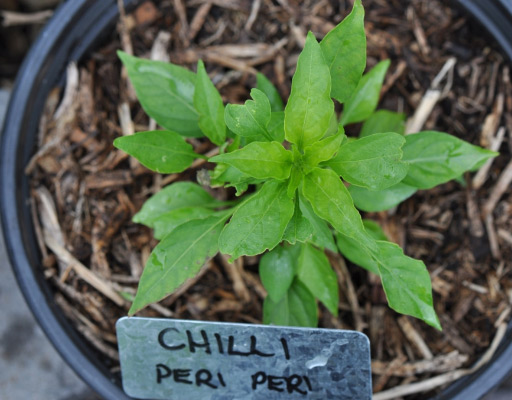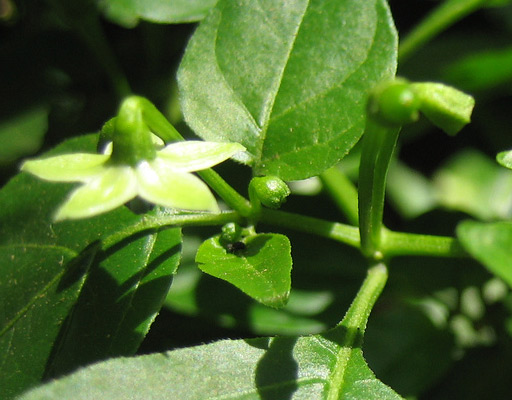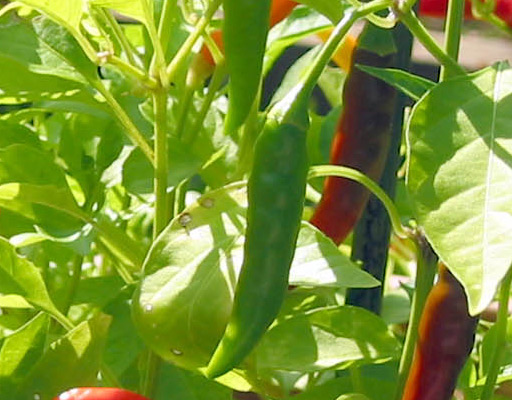Hot Peppers: Piri Piri (Peri Peri)

Seedling 
Flower 
Unripened 
Fully Ripe
Introducing the Piri Piri
The diminutive piri piri pepper, whose ancestor plants hail from ancient South America, has taken hold in Africa over the past several centuries, growing wild and also being cultivated by people from South Africa to Nigeria, Ethiopia to Mozambique.
The name of this chili pepper is pronounced and spelled differently, depending on where it is used. Called 'piri piri' in several African languages ('pepper pepper'), in Portuguese-speaking Mozambique it carries the identical name, while in Malawi it is called 'peri peri'. The name can also refer to the spicy sauces made with the pepper. Piri piri is variously known as the African Bird's-Eye pepper, or African Red Devil pepper.
Small, Easy-to-Grow Plant
Piri piri fruit is smallish, measuring one to two inches long when ripe and red. The bush that produces it can also be small, and can be grown in containers, even indoors. The sprout takes a couple weeks to peek out from under the soil, with leaves at first very dark, then later, medium green. To produce flowers, a potted piri piri will need at least a 10-inch pot. Once flowers are well open, it helps the self-pollination process to give the plant a gentle shake.
Flowers begin pointing downwards, and then as the fruit beings to grow, it starts pointing (mostly) upwards.
Where Piri Piri Stands Among Hot Peppers
This pepper is hot for sure, but, with a Scoville ranking of 175,000 piri piri ranks at the bottom end of 'habanero-hot'. By comparison, bell peppers and banana peppers rate between 100 and 900 Scoville units, while the very hottest peppers clock in at a whopping 2,000,000 (that's million) units!
The deceptive little piri piri is definitely within the top third of the Scoville scale, but when balanced well in a dish, the heat only shows up at the end of your mouthful, not throughout, making it preferable for many who want the experience of a true hot pepper, without the tastebud blowout.
Traditional Cooking Using Piri Piri
In African and Portuguese cultures, the piri piri is often used in a marinade with variations on the following range of ingredients: piri piri, onion, garlic, black pepper, salt, lemon zest and/or lemon juice, basil, bay leaf, tarragon, oregano, pimento and paprika.
By far piri piri's most popular culinary partner is chicken, though it has been suggested that daring adventurers might even like it in ice cream!
Foodies all over the world are onto piri piri peppers. Some have even called its taste, “light, fresh, and herbal!” I'm guessing these are connoisseurs of the higher Scoville ranks! If you like a hotter pepper, but prefer one that doesn't bring the phrase “scorched earth” to mind, give piri piri a try!
Recently Added Hot Sauces that Use Peri Peri Peppers
- Bullwhip - Kelp Hot Sauce
- Captain Mowatt's - Canceaux Sauce
- Jimmy's Sauces - Peri-Peri Sauce
- Avila Gorilla - Pineapple Mango Hot Sauce
- Steers - Hot Peri Peri Sauce
- Nando's - Extra Hot Peri Peri Sauce
- Veri Peri Hot Sauce
- Calvé Piri Piri Portuguese Traditional Recipe
*Note that many hot sauces do not specify the type of pepper used on their list of ingredients, and instead use a general phrase like “chile pepper”, so a number of sauces on our hot sauce list may not be included.
References and Attribution:
- http://www.eatboneheads.com/the-piri-piri-story.html
- http://www.tastedefined.com/2011/01/10-spiciest-chillies-in-world.html
- http://rhianni32.hubpages.com/hub/African-Red-Devil-pepper
- https://www.salemspice.com/2/post/2013/03/peri-peri-or-piri-piri.html
- http://en.wikipedia.org/wiki/Scoville_scale
- http://seattletimes.com/html/foodwine/2013753836_seasoningsperiperi25.html
- http://www.epicurious.com/recipes/food/views/Piri-Piri-Chicken-359750
- Photo: Chilli, Peri Peri (seedling) by Glenn (graibeard) (CC-BY-SA-2.0) via Flickr
- Photo: Some little piri-piri fruits by Mezga (CC-BY-NC-ND-2.0) via Flickr
- Photo: The peri peri again, by Interstellar (CC-BY-NC-ND-2.0) via Flickr
